Talking SOP september 2007 [PDF, 487.54 Kb] - Tessenderlo Group
Talking SOP september 2007 [PDF, 487.54 Kb] - Tessenderlo Group
Talking SOP september 2007 [PDF, 487.54 Kb] - Tessenderlo Group
You also want an ePaper? Increase the reach of your titles
YUMPU automatically turns print PDFs into web optimized ePapers that Google loves.
Sulphate of Potash newsf from <strong>Tessenderlo</strong> <strong>Group</strong><br />
September <strong>2007</strong><br />
<strong>SOP</strong> market looks set to remain<br />
extremely tight going into 2008<br />
As global demand for fertilizers remains strong, driven largely by the increasing<br />
interest in biofuels, many MOP producers are reporting record earnings. In<br />
recent weeks reports suggest that MOP prices continue to climb to unprecedented<br />
levels, having reached US$330/mT CFR South East Asia for shipments of<br />
standard MOP in the fourth quarter of <strong>2007</strong>. Inevitably the high freight rates at<br />
present are also having an impact on prices.<br />
In this issue<br />
Bananas: the most popular<br />
tropical fruit p2, 3<br />
<strong>Tessenderlo</strong> <strong>Group</strong> launches new<br />
Customer Services Team for its<br />
Inorganics Business Unit p4<br />
Despite these price increases, the MOP market<br />
remains very tight with many suppliers effectively<br />
sold out until the end of <strong>2007</strong>. Not surprisingly<br />
many producers have initiated projects designed<br />
to increase their production capacity but<br />
additional tonnage will not be available<br />
immediately. Indications suggest that a significant<br />
part of the planned capacity increase will not be<br />
realised before 2009-2010.<br />
With global potash consumption predicted to<br />
grow at a rate of 3-4% in the short to medium<br />
term, it is likely that the supply and demand<br />
balance may even tighten in 2008 as capacity<br />
increases struggle to keep up with market growth.<br />
In the medium term, however, the situation should<br />
improve as the balance is restored.<br />
Increased demand for <strong>SOP</strong><br />
<strong>SOP</strong>, a specialty potash fertilizer, represents only<br />
around 6-7% of the total potash market but<br />
demand for the product in recent years has grown<br />
at a similar rate to that of the global potash<br />
market.<br />
Euro/US Dollar exchange rate: March - July <strong>2007</strong><br />
With more than half the world’s <strong>SOP</strong> production<br />
coming from the Mannheim or related processes<br />
(those where potassium chloride is chemically<br />
reacted with a sulphate source - sulphuric acid in<br />
the case of the Mannheim process or alternatively<br />
sodium sulphate), the market price for <strong>SOP</strong> is<br />
inevitably linked to global MOP prices since <strong>SOP</strong><br />
producers have to secure a supply of their raw<br />
materials on the open market. It is not surprising,<br />
therefore, that <strong>SOP</strong> prices have risen sharply in<br />
line with MOP prices, as <strong>SOP</strong> producers face<br />
rapidly rising production costs.<br />
In early May, prior to the IFA conference in<br />
Istanbul, rumours were circulating of a €15-20/mT<br />
increase in the price of MOP for the third quarter<br />
of <strong>2007</strong>. In reality the increase has been even<br />
more drastic with actual increases reported to be<br />
closer to €30/mT.<br />
This increase is reflected in the new <strong>SOP</strong> prices<br />
for the third quarter of <strong>2007</strong> which are generally<br />
up €25-30/mT on the previous quarter, reflecting<br />
not only the MOP price increase, but also<br />
increases in the cost of sulphuric<br />
acid and energy (the increase<br />
has been even greater in those<br />
countries where price levels were<br />
below average).<br />
Export market increases<br />
While around half of the present<br />
global <strong>SOP</strong> capacity is within<br />
Europe, the consumption of <strong>SOP</strong><br />
here represents just under one<br />
third of global consumption.<br />
Consequently there is a net<br />
export of <strong>SOP</strong> out of Europe,<br />
which exposes producers to<br />
fluctuations in the US$/€ exchange<br />
rate. The steady weakening of<br />
the US dollar against the euro<br />
during the first half of <strong>2007</strong> has<br />
meant that in many cases price<br />
increases in export markets have<br />
Nicolas White<br />
Marketing Manager Fertilizers<br />
been even more pronounced than in Europe, at<br />
levels of US$45-50/mT.<br />
“Somewhat ominously, reports are already<br />
circulating that MOP producers will look for an<br />
additional price increase of €10-15/mT for the<br />
fourth quarter of <strong>2007</strong>,” comments Nicolas White,<br />
Marketing Manager for Fertilizers.<br />
“Only time will tell whether this is achieved but<br />
MOP suppliers continue to remain bullish. Any<br />
further increase in MOP prices will inevitably have<br />
an impact on the <strong>SOP</strong> market. Nevertheless, at<br />
present <strong>Tessenderlo</strong> <strong>Group</strong> is effectively sold out<br />
of <strong>SOP</strong> until the end of September and supply will<br />
certainly remain tight in the near future.” ■<br />
SoluPotasse ® GranuPotasse ® Standard <strong>SOP</strong>
Bananas: the most popular tropical fruit<br />
Bananas are ranked second in world fruit production behind citrus fruit, which covers many different varieties. With more<br />
than 80 million tons produced on 4.2 million hectares, bananas are the world's favourite tropical fruit, particularly as far<br />
as children are concerned. Bananas have many benefits: they are full of energy, hygienically enclosed and easy to peel,<br />
hold and eat. Although most bananas are grown by small farmers for local consumption, large plantations controlled by<br />
three international companies produce 75% of the banana export market, mainly in the form of the 'Cavendish' variety.<br />
The banana is an herbaceous plant from the<br />
Musaceae family, originating from the tropical<br />
areas of Southeast Asia and Australia. Its fruit<br />
grows in hanging clusters, with up to 20 bananas<br />
to a hand and between 8-20 hands to a bunch -<br />
the total of the hanging clusters, which can weigh<br />
from 30-50 kg. The average fruit weight is 125g of<br />
which approximately 75% is water and 25% dry<br />
matter.<br />
The banana is a valuable source of potassium,<br />
Vitamin A, Vitamin B6 and Vitamin C (see table 1).<br />
Banana plants are cultivated primarily for their<br />
fruit, such as the dessert or sweet banana. Unripe<br />
or "green" bananas and plantains are used in<br />
cooking and banana plants are used, to a lesser<br />
extent, for the production of fibres or as<br />
Table 2: Banana producing and exporting countries<br />
Producers Production (tons) Area (ha) Exporters Export (tons)<br />
India 11,710,300 404,200 Ecuador 3,942,000<br />
Brazil 7,088,000 504,074 Costa Rica 1,883,000<br />
Philippines 6,794,560 428,804 Philippines 1,600,000<br />
China 6,708,000 274,200 Colombia 1,524,000<br />
Ecuador 6,118,400 221,085 Guatemala 801,000<br />
Indonesia 4,503,500 315,000 Panama 537,000<br />
Costa Rica 2,352,600 42,700 West Indies 403,000<br />
Mexico 2,196,900 74,350 Ivory Coast 217,000<br />
Thailand 1,864,800 140,935 Cameroon 206,000<br />
Colombia 1,764,500 140,935 Honduras 150,000<br />
Burundi 1,538,700 303,420 Belize 68,000<br />
Vietnam 1,344,200 93,900 China 50,000<br />
Guatemala 1,070,500 19,305 Nicaragua 45,000<br />
World 80,000,000 4,546,000<br />
Source: FAO 2006<br />
Phosphorus is applied at planting and later<br />
broadcast in ratoon crops. Nitrogen and<br />
potassium are applied in split applications,<br />
throughout the cropping period. Fertigation is the<br />
best method of fertilizer application to match the<br />
demands of the plant.<br />
Table 1: Banana nutritional value<br />
(per 100g)<br />
Energy<br />
Potassium<br />
Calcium<br />
Magnesium<br />
Phosphorus<br />
Sugars<br />
Fibres<br />
Protein<br />
Vitamin C<br />
Vitamin B1<br />
Vitamin B2<br />
Vitamin B3<br />
Vitamin B5<br />
Vitamin B6<br />
90 kcal (370 kJ)<br />
358 mg<br />
5 mg<br />
27 mg<br />
22 mg<br />
12.23 g<br />
2.6 g<br />
1.09 g<br />
8.7 mg<br />
0.031 mg<br />
0.073 mg<br />
0.665 mg<br />
0.334 mg<br />
0.367 mg<br />
ornamental plants. The most important countries<br />
exporting bananas are not the biggest producers<br />
(see table 2) and export markets represent only<br />
15% of world production.<br />
General mineral nutrition<br />
Balanced fertilization is the guarantee of high<br />
quality, marketable fruit production, an important<br />
issue for large plantations producing bananas for<br />
export.<br />
The banana plant prefers deep soils, good<br />
drainage and a pH from 5.5 to 6.5, though it is<br />
cropped on a wide range of soils. A standard field<br />
production (50-60 t/ha) requires 500-600 kg N/ha,<br />
200 kg P 2 O 5 /ha and 1,300-1,500 kg K 2 O/ha.<br />
SoluPotasse ® GranuPotasse ® Standard <strong>SOP</strong>
Table 3: Effect of nitrogen and potasium<br />
fertilization on banana production<br />
Treatment*<br />
Yield parameter<br />
Tons/ Kg/ Hands/ Fruit/<br />
ha bunch bunch hand<br />
N1PK1 33.75 11.3 10.0 16.0<br />
N1PK2 36.25 12.5 10.0 16.0<br />
N1PK3 40.00 17.9 11.0 17.0<br />
N1PK4 42.50 18.2 12.0 20.0<br />
N2PK1 50.50 20.5 11.0 18.0<br />
N2PK2 66.50 24.1 11.0 20.0<br />
N2PK3 75.25 27.3 12.0 25.0<br />
N2PK4 84.75 30.0 13.0 25.0<br />
*N - N1: 250 kg/ha, N2: 500 kg/ha; K 2 0 - K1: 250 kg/ha,<br />
K 2 : 500 kg/ha, K3: 750 kg/ha, K4: 1000 kg/ha)<br />
Source: DRC Egypt <strong>2007</strong><br />
Potassium, the key element<br />
The banana plant has the highest requirement for<br />
potassium among all crops and potassium plays<br />
an essential role in fruit yield and quality. It<br />
stimulates early shooting and significantly<br />
shortens the time required for fruit to mature,<br />
improving bunch grade and finger size.<br />
Potassium deficiency symptoms include the<br />
orange/yellow colour of old leaves, scorching<br />
along the leaf margins, reduction in total leaf area,<br />
curving of the midribs, etc. Leaf choking delays<br />
flower initiation and leads to a reduction in fruit<br />
yield and quality - the fruit is badly shaped, poorly<br />
filled and unsuitable for market.<br />
Potassium deficiency in banana leaves<br />
Potassium sulphate for high quality<br />
production<br />
The banana plant is sensitive to chloride, which<br />
affects fruit yield and taste. A high chloride<br />
concentration disturbs the plant's water<br />
exchange and reduces its element uptake from<br />
the soil. The risk is enhanced in cases of saline<br />
irrigation water or poorly draining soils.<br />
A number of experiments comparing potassium<br />
sulphate (<strong>SOP</strong>) and potassium chloride (MOP)<br />
treatments at the same dose of potassium<br />
illustrate the detrimental effect of chloride. A 12 to<br />
20% increase in total production is usually<br />
observed between treatments with potassium<br />
sulphate over potassium chloride.<br />
Potassium sulphate has also a positive effect on<br />
quality parameters. The illustration below from an<br />
experiment in India compares <strong>SOP</strong> and MOP<br />
application at 330g/tree on total soluble sugar<br />
and on the sugar /acidity ratio, as well as on<br />
production parameters (see below).<br />
150<br />
130<br />
110<br />
90<br />
70<br />
50<br />
MOP and <strong>SOP</strong> effect on quality<br />
Sugar/acidity<br />
Source: Ebert - India (2004)<br />
Control MOP <strong>SOP</strong><br />
No. fingers/bunch<br />
Sulphur also plays a key role, as it is the main<br />
component of amino acids and vegetal proteins.<br />
0.23% S in the banana leaf is<br />
considered as the critical concentration.<br />
Deficiency symptoms include<br />
a generalized yellowing of the foliage,<br />
with new leaves displaying light<br />
colours.<br />
This is consistent with the fact that<br />
sulphur in not a mobile element<br />
within the plant and deficiency<br />
symptoms should be most apparent<br />
on the youngest foliage. Plants with<br />
severe sulphur deficiency will<br />
develop necrotic leaf margins and a<br />
slight thickening of the veins.<br />
For standard production, <strong>SOP</strong> largely<br />
covers the banana plant's sulphur<br />
requirements.<br />
The use of SoluPotasse ®<br />
As with many fast growing plants, the banana<br />
benefits from foliar application of fertilizers.<br />
SoluPotasse ® , <strong>Tessenderlo</strong> <strong>Group</strong>'s soluble grade<br />
of potassium sulphate, contributes to high quality<br />
production and a better efficiency of a basal<br />
dressing.<br />
SoluPotasse ® can also be used in fertigation to<br />
allow growers to apply nitrogen and potassium<br />
separately. An example of a fertigation programme<br />
for standard banana production is presented in<br />
table 4 below.<br />
Table 4: Typical fertigation programme<br />
for bananas<br />
N P 2 O 5 SoluPotasse ®<br />
Weeks after (kg/ha/week) (kg/ha) (kg/ha/week)<br />
planting<br />
0 to 6 10 200 35<br />
6 to 12 15 - 50<br />
12 to 18 20 - 50<br />
18 to 24 15 - 85<br />
24 to 30 15 - 65<br />
30 to 36 15 - 50<br />
36 to 42 15 - 85<br />
Total 630 kg/ha 200 kg/ha 2,520 kg/ha*<br />
* (1,260 kg K 2 O)<br />
Bananas are an essential food in many developing<br />
countries where they form the basis of nutrition.<br />
Banana production also plays an important role in<br />
the world economy.<br />
Potassium is necessary for banana growth and<br />
<strong>SOP</strong> contributes in an important way to high<br />
quality production. ■<br />
SoluPotasse ® GranuPotasse ® Standard <strong>SOP</strong>
<strong>Tessenderlo</strong> <strong>Group</strong> launches new Customer<br />
Services Team for its Inorganics Business Unit<br />
As part of our continuing drive to improve the relationship with our customers, <strong>Tessenderlo</strong> <strong>Group</strong> has been in the<br />
process of re-organizing its supply chain. One of the outcomes of this project is the creation of a new centralized<br />
Customer Services Team under the direction of John Kraft, based at our site in <strong>Tessenderlo</strong>. The Team became<br />
operational at the beginning of July.<br />
The new Customer Services Team for the<br />
Inorganics Business Unit is led by Ariane<br />
Goovaerts and is made up of Customer Service<br />
Representatives (CSRs) who handle the complete<br />
end-to-end order process, from customer order<br />
intake right through to shipment and invoicing.<br />
This change gives the CSRs complete control<br />
over the whole order processing chain, ensuring<br />
that our customers can be quickly updated on the<br />
progress of their orders.<br />
The CSRs are now at your disposal to handle<br />
order intakes, transport booking and call-offs,<br />
invoicing and all order-related questions. Each<br />
CSR has responsibility for a portfolio of clients and<br />
products, which are shown in the table below.<br />
Naturally, all commercial topics, such as pricing<br />
and sales conditions, will remain the responsibility<br />
of your Sales Manager.<br />
Clients in Spain, Italy, Germany, Holland and the<br />
UK and Ireland should continue to contact their<br />
respective local offices in Madrid (TC España);<br />
Cologna Veneta (Italphos); Hamburg (HGS);<br />
Rotterdam (TCR) and Leeds (Britphos) for all<br />
enquiries related to order processing.<br />
When placing orders and communicating with the<br />
Customer Services Team, clients should ensure<br />
that from now on correspondence is sent by e-<br />
mail, post or fax to the following centralised<br />
coordinates:<br />
Central fax (France): +33 3 20 22 58 07<br />
Central fax (Other countries): +32 2 647 3692<br />
Central e-mail: inorganics.sales@tessenderlo.com<br />
Postal address: <strong>Tessenderlo</strong> Chemie N.V.,<br />
Department OTC (Inorganics), Heilig Hartlaan 21,<br />
3980 <strong>Tessenderlo</strong>, Belgium.<br />
Director John Kraft outside the Customer Service Team<br />
building at <strong>Tessenderlo</strong>.<br />
Client/product responsibilities Customer Services Telephone number<br />
Representative<br />
Team Leader Inorganics Ariane Goovaerts +32 13 612752<br />
France & Belgium Olivier Dubois +33 3 20 22 58 11 (France)<br />
(<strong>SOP</strong> & Phosphates)<br />
+32 13 612747 (Other countries)<br />
Trade Products & DCP 17 Evy Soentjens +33 3 20 22 58 43 (France)<br />
(all countries)<br />
+32 13 612748 (Other countries)<br />
Valérie Gochel +33 3 20 22 58 54 (France)<br />
+32 13 612750 (Other countries)<br />
Sonia Viaene +32 13 612759<br />
Peggy Verboven +32 13 612749<br />
Overseas Export Gabriele Mini +32 13 612751<br />
(<strong>SOP</strong> & Phosphates)<br />
Katrien Bylemans +32 13 612753<br />
Jessie Alenteyns +32 13 612754<br />
Netherlands; Germany; FSU & Eastern Maarten Verheyen +32 13 612755<br />
Europe (<strong>SOP</strong> & Phosphates) Dajana Cotza +32 13 612730<br />
Claims Processing Guy Sevenants +32 13 612715<br />
“The centralized coordinates will help ensure all<br />
orders receive immediate attention even in the<br />
absence of your regular CSR. In addition, all<br />
orders received via these coordinates will be<br />
automatically archived in case of queries at a later<br />
date,” explains John Kraft.<br />
“When using these new coordinates, we<br />
guarantee that your order will be handled<br />
immediately. You are therefore requested not to<br />
use the old telephone and fax numbers from now<br />
on, otherwise you may find that your order is not<br />
processed. You are, of course, free to copy<br />
communications sent to the central coordinates<br />
to your regular CSR and Sales Manager if you feel<br />
that this is necessary.”<br />
“<strong>Tessenderlo</strong> <strong>Group</strong> is convinced that working<br />
with dedicated Customer Service Representatives<br />
will strengthen our co-operation. Your help in<br />
ensuring a smooth transition is greatly<br />
appreciated.” ■<br />
More information on <strong>Tessenderlo</strong> <strong>Group</strong>’s activities can be<br />
found at: www.tessenderlogroup.com<br />
<strong>Tessenderlo</strong> <strong>Group</strong> Fertilizers<br />
giving nature a helping hand<br />
www.sopib.com<br />
<strong>Tessenderlo</strong> Chemie N.V.<br />
Heilig Hartlaan 21, B-3980 <strong>Tessenderlo</strong>, Belgium<br />
Tel: +32 13 612211 Fax: +32 2 647 3692<br />
www.tessenderlogroup.com<br />
fertilizers@tessenderlo.com<br />
SoluPotasse ® and GranuPotasse ® are registered trademarks of <strong>Tessenderlo</strong> <strong>Group</strong>.


![Talking SOP september 2007 [PDF, 487.54 Kb] - Tessenderlo Group](https://img.yumpu.com/37691458/1/500x640/talking-sop-september-2007-pdf-48754-kb-tessenderlo-group.jpg)
![Slides [PDF, 378.59 Kb] - Tessenderlo Group](https://img.yumpu.com/49205668/1/190x143/slides-pdf-37859-kb-tessenderlo-group.jpg?quality=85)
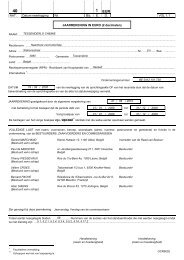
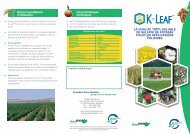
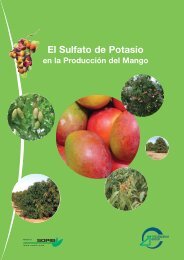
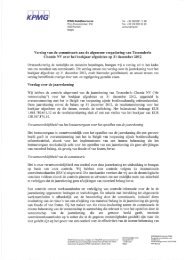

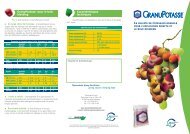
![Investor Seminar Presentation [PDF, 997.72 Kb] - Tessenderlo Group](https://img.yumpu.com/45992427/1/190x143/investor-seminar-presentation-pdf-99772-kb-tessenderlo-group.jpg?quality=85)
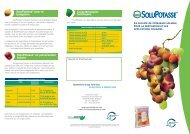
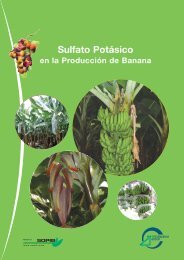
![Talking SOP May 2013 [PDF, 735.49 Kb] - Tessenderlo Group](https://img.yumpu.com/41045284/1/184x260/talking-sop-may-2013-pdf-73549-kb-tessenderlo-group.jpg?quality=85)
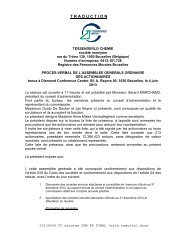

![Talking SOP September 2012 [PDF, 673.84 Kb] - Tessenderlo Group](https://img.yumpu.com/37691694/1/184x260/talking-sop-september-2012-pdf-67384-kb-tessenderlo-group.jpg?quality=85)
![Annual Report 2008 English [PDF, 2.69 MB] - Tessenderlo Group](https://img.yumpu.com/37691533/1/184x260/annual-report-2008-english-pdf-269-mb-tessenderlo-group.jpg?quality=85)